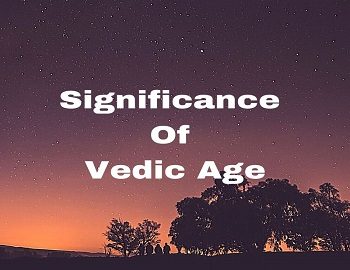Significance Of Vedic Age:
The Vedic Age has directly contributed to the evolution of social structure and cultural aspects of Northern India. The Vedic Culture expanded even towards Southern parts of India and other parts of the subcontinent too. So in that sense, it contributed to the evolution of a pan India society, especially after the decline of megalithic culture in South India.
Unlike the Harappans, the Vedic Aryans seem to be more flexible in their approach to life. It was this flexibility that helped them to broaden their area of political influence. They not only fought against the indigenous tribes but also slowly assimilated their cultural traits. For example, though Vedic Aryans were basically cattle breeders, they adopted agriculture as a result of this contact and expanded further towards the Ganga-doab region. With the help of better arms and chariots, they won over their enemies and later even effectively coped up with the forces of nature and the environment. This enabled them to start a settled life with permanent habitat.
The study of Vedic literature shows that Aryans were optimistic and progressive in their approach. This aspect can be seen in their ability to leave their earlier regions in the west and move towards the east, and in the process adopting new traits that would suit their migration. They sang the song of joy in life and never talked about death (except that of their enemies). It was mainly due to this kind of approach coupled with the ability to assimilate the new cultural traits they encounter, that the Vedic Aryans were able to expand their influence from northwest to the entire part of north India within a period of 1000 years.
The fundamentals of the political, social and cultural institutions of India derive its source from Vedic Civilization. For example, monarchy and bureaucracy in the political field and fundamental Varna and Caste structure in the social field had been influenced by the Vedic Civilization. Even the basic tenets of social equality were more dominant as the social division during Vedic age was based on occupation but not on birth. The condition of women was much better compared to the later ages. Because of this reason only the modern reformers had accepted the Vedic age as an ideal model for society.
The dietary or eating habits and their way of life affected Indian society to a great extent. For example, prior to the arrival of Vedic Aryans the cattle breeding activity done was only for obtaining meat. But Vedic Aryans introduced the practice of cattle breeding for getting milk and milk products and this practice continues till date.
In the religious field, the “this-worldly” approach of Aryans was reflected in their way of worship as their main objective was to gain material happiness rather than salvation. So even in the 19th century, the Indian religious reformers were attracted to this aspect of the Vedic Age as is evident from the various examples cited by the reformers to attack untouchability, idol worship and other religious obscurantism of 19th century India. This worldly approach of Aryans is also visible in the modern age too.
The important significance of Vedic philosophy was its contribution to the development of monism of Shankaracharya, which laid its main stress on the relationship between the Brahman and the soul. In due course, this doctrine became an inspiration for further developments in Indian philosophy, up to the age of Vivekananda and even till date.
Vedic scripture talks about the development of science and literature. In Rigveda, the hymns that were dedicated to goddess Usha reflects a higher pedigree of poetic tradition. In the field of arithmetic, the Vedic Aryans used the decimal system. Similarly in Rigveda, we hear about the presence of physicians. Atharvaveda is an important text on medicine.
- Social Condition Of Mauryan India
- The Khilji Dynasty (1290-1320)
- The Bhakti Movement
- Subsidiary Alliance- Merits And Demerits
- The Khilafat Movement, 1919-1920
- The Non-Cooperation Movement (1920-22)
- Simon Commission, 1927
- Gandhi-Irwin Pact: March 5, 1931
- The Government of India Act 1935
- Wardha Scheme of Basic Education, 1937
- National Liberation Movements– NIOS




![Causes of French Revolution [1789] 5 Causes of French Revolution](https://gkscientist.com/wp-content/uploads/2021/05/Causes-of-French-Revolution.jpg)




Comments (No)